wikiHow is a “wiki,” similar to Wikipedia, which means that many of our articles are co-written by multiple authors. To create this article, 17 people, some anonymous, worked to edit and improve it over time.
This article has been viewed 163,263 times.
Learn more...
Prior to the 1970s, spinning kicks were less popular in Taekwondo and were considered too risky to be used for all but the most experienced competitors. Roundhouse and side kicks were dominant for knockouts then, and spinning kicks seemed just too slow and obvious. But with the significant evolution of Taekwondo since, including the advent of modern footwork and the refinement of strategic maneuvers, spinning kicks have become the most powerful and dangerous kicks in the tae kwon do competitor's arsenal. Sanshou also uses spinning kicks and is a much more efficient and effective art when compared to Taekwondo. However, with the rise of spinning kicks came the rise of such kicks like the spinning side kick and the back kick. These kicks are indeed affective but they are easily vulnerable to counterattacks either during or shortly after the kicks has been performed. The question arose in many Taekwondo competitors, life-long dedicated and still only a Newbie: Was there a spinning kick out there that was both effective and not as vulnerable to counterattacks? The answer is yes, and that kick comes in the Spinning Hook Kick--when done properly could easily knockout an opponent.
Steps
-
1Make sure you can properly do a Hook Kick in the first place. If you don't and just want to get straight to the Spinning Hook Kick, then read on for it will also contain how to do a Hook Kick, intertwined with the spinning aspects of this effective and efficient move.
-
2Get in the fighting stance. For this kick, I found, it's better if your knees are bent a little more and if your legs are wider apart because that way you will be able to kick a lot higher. How much you lean back on your non-kicking leg also has influence on how high your kick will be.[1]Advertisement
-
3Fists clenched tight and strong, legs digging deep into the ground stable, get ready to turn. If you're gonna kick with your right leg, step in with your left leg. If you're gonna kick with your left leg, step in with your right leg. If you kick with your right leg, your right leg should be out in front of you and your back or left leg trailing behind which you will bring around in front which will start the spinning aspect of the hook kick. And vice versa with the other leg.
-
4To spin more quickly and confidently, therefore having more momentum and power in your kick, begin to swing your arms around with the stepping of your non-kicking leg in front of you.
-
5Now, you've spun about 180 degrees and are looking over your kicking leg's shoulder. Some people who perform this kick make the mistake of not looking over their shoulder confidently and therefore not looking into their opponent's eyes confidently and instead looking at the ground. Don't do this! This not only makes you look stupid and timid and uncertain, it also dampens your target and aim of knockout: the opponents head. Also, there is a higher risk of falling flat on your face.[2]
-
6Now comes the actual kick. Let's briefly go over The Hook Kick. It's self-explanatory really. The kick goes in the motion of a hook. For this, imagine a fish hook. Or the hook attached to a Pirate Captain's missing hand. There's a fs and bs Hook Kick and fs and bs with practically all other kicks, but in this WikiHow we are going over the bs kick so don't get it mistaken with the fs spinning hook kick. If you can't tell a fs spin hook between a bs spin hook then maybe this will help: If you are doing a fs spin hook kick with your right leg then you are spinning left rather than right and doing your kick from there. And vice versa with the other leg. But with the bs spin hook kick, the one we are going over in this WikiHow, you are spinning right and then doing your kick from there. So now, once again, onto the actual kick. The(stationary) bs Hook Kick. This is the one for kicking with your right leg. So, you're in stance, right leg in front, left leg in back. Same concept with your fists covering your face. Leaning most of your weight on your non-kicking(left)leg, you begin to bring up the kicking(right)leg in a sweeping, rainbow curvature like hook motion with the sharp, glimmering point ending at the right. You are using either the heel or the ball of the foot to inflict damage upon your opponents head. This may come naturally but it is recommended that when you begin the kick you turn your non-kicking, standing leg slightly more to the left so your kicking leg can have more space to make a wider and therefore more affective arch in its kick.[3]
-
7Now back to the Spinning Hook Kick. So, you're turned about 180 degrees and you are looking over your shoulder, your fists clenched tightly up to your chest. From here, lift up your kicking leg and do a Hook Kick like how we went over in step 6. Since you're spinning you will have more momentum in your hook kick and may even flip your opponent over if you kick him/her in the head hard enough, with a grand sweep, almost shoving.[4]
-
8Once you have done this, bring your kicking foot back to your side, and your other leg will naturally pivot along with it but this time as you are back in stance, your right leg will be behind you and your left leg will be in front of you.[5]
-
9From here you can finish your opponent off with a roundhouse kick to your opponents gut-better your opponents head again. When you bring both legs back down it'll be like Step 2 again and you can get ready for another spinning hook kick but by now, s/he will surely be on the ground, wanting absolutely no more of you.
Community Q&A
-
QuestionHow do I practice?
 Community AnswerPractice the kick in a large area with plenty of room. Warm up and stretch first. Keep doing the move until you get it down.
Community AnswerPractice the kick in a large area with plenty of room. Warm up and stretch first. Keep doing the move until you get it down. -
QuestionHow can I get higher kicks?
 Community AnswerTry leaning back more and increasing your leg flexibility. Use an exercise like the splits.
Community AnswerTry leaning back more and increasing your leg flexibility. Use an exercise like the splits. -
QuestionIs this more effective than a spinning back kick?
 Community AnswerThe spinning hook kick motion is from the side while the spinning back kick is front on to your opponent's gut. The aftermath of the spinning back kick will leave you vulnerable and there is a chance of pulling a muscle, therefore the spinning hook kick is better as a move after a split hit to a vulnerable area.
Community AnswerThe spinning hook kick motion is from the side while the spinning back kick is front on to your opponent's gut. The aftermath of the spinning back kick will leave you vulnerable and there is a chance of pulling a muscle, therefore the spinning hook kick is better as a move after a split hit to a vulnerable area.
Warnings
- When you are trying to kick your opponent directly with your heel rather than with the ball of your foot, maintaining balance is more difficult and you are at higher risk of falling down and hurting yourself. Although, using your heel is much more effective than using the ball of your foot.⧼thumbs_response⧽
- This kick, like all other spinning kicks, has a less accurate aim because these kicks are dependent mostly on peripheral vision; most people's peripheral vision is not that sharp. While you may be aiming at someone's head with a kick like this, you could end up missing-even if by a bare inch-and become open and vulnerable for a counter attack. Not only on good peripheral vision do these spinning kicks rely on for perfect aim and striking, it also depends a good deal on footing and how far away or how close you are from your opponent. There are many instances in various sports like Kickboxing where a fighter attempts to spin hook kick their opponents head and knock them out, but they are too close to their opponent and they end up with their foot being hooked over their opponents shoulder; from here, he can easily grab onto the other fighter's leg and trip them over. So, if you are ever going to attempt a kick like this, always be sure to practice a lot and get your aim and peripheral vision and footing and how far you are from your opponent, perfect, otherwise you could miss and it could backfire with you ending up on the ground knocked out instead of your opponent.⧼thumbs_response⧽
- Practice this move slowly at first and then pick up speed. Spinning too fast or too slow, could result in you jamming and slipping, falling down and hurting yourself.⧼thumbs_response⧽
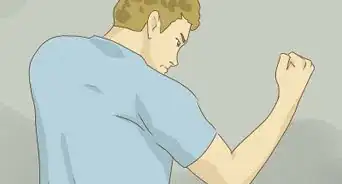
-Step-15-Version-2.webp)
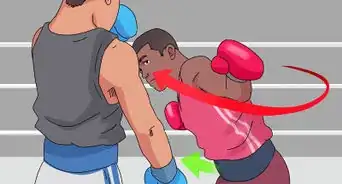
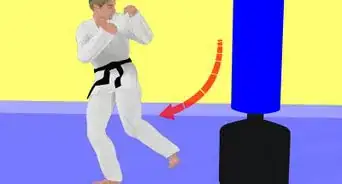


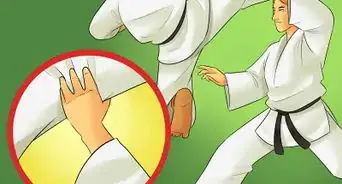

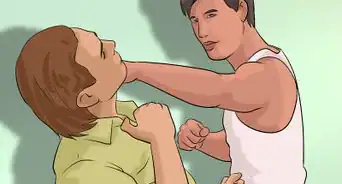






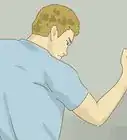
-Step-15-Version-2.webp)




































